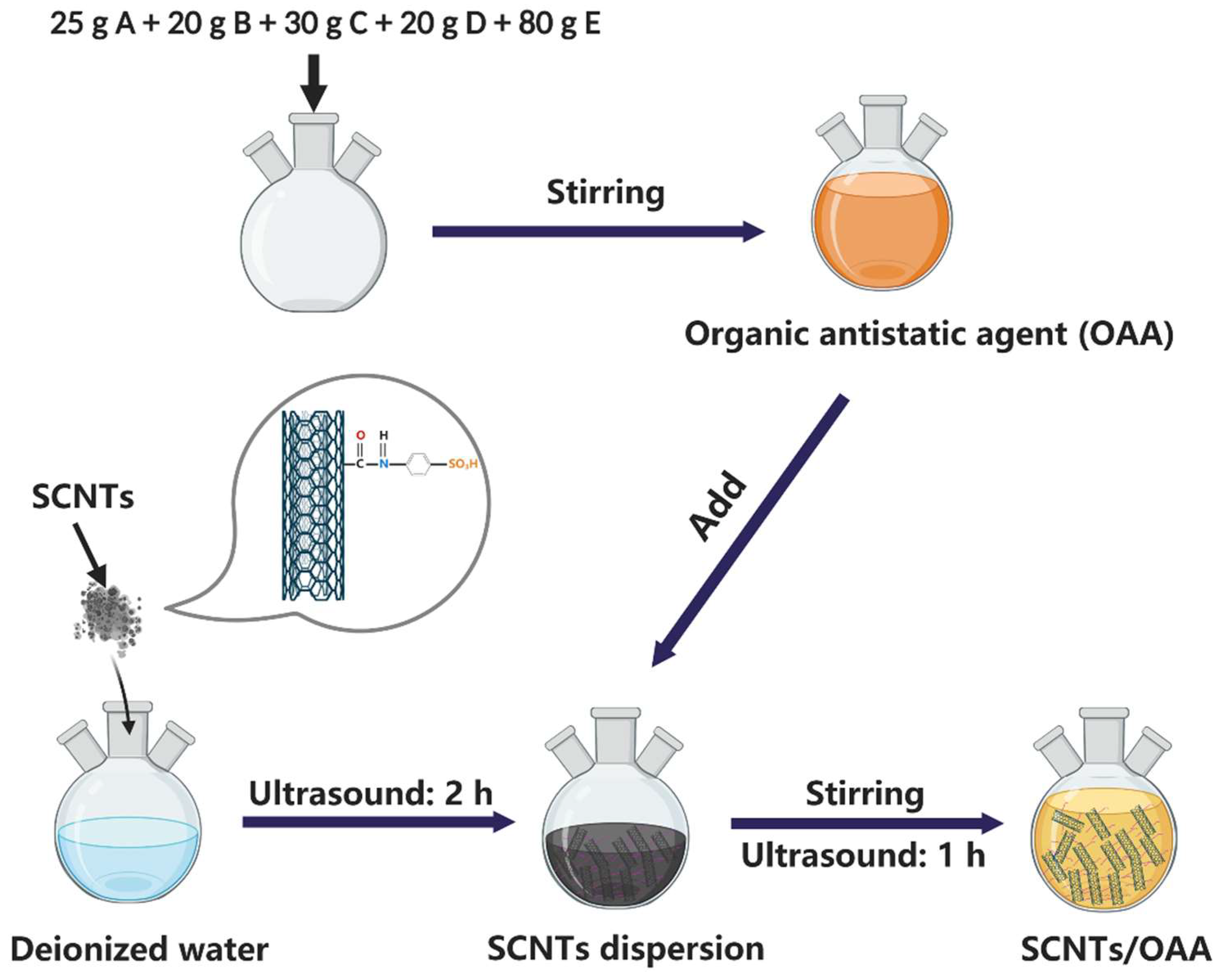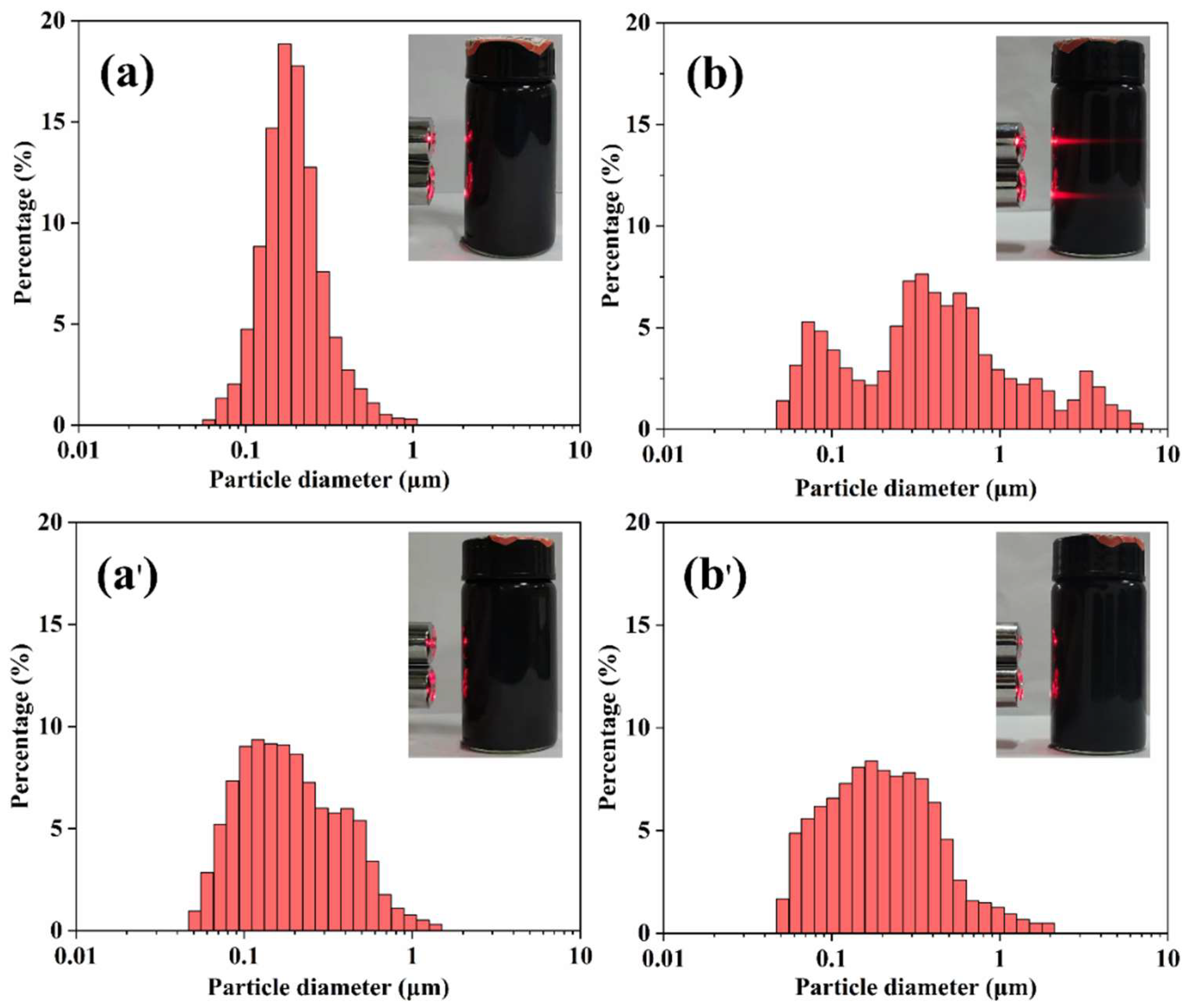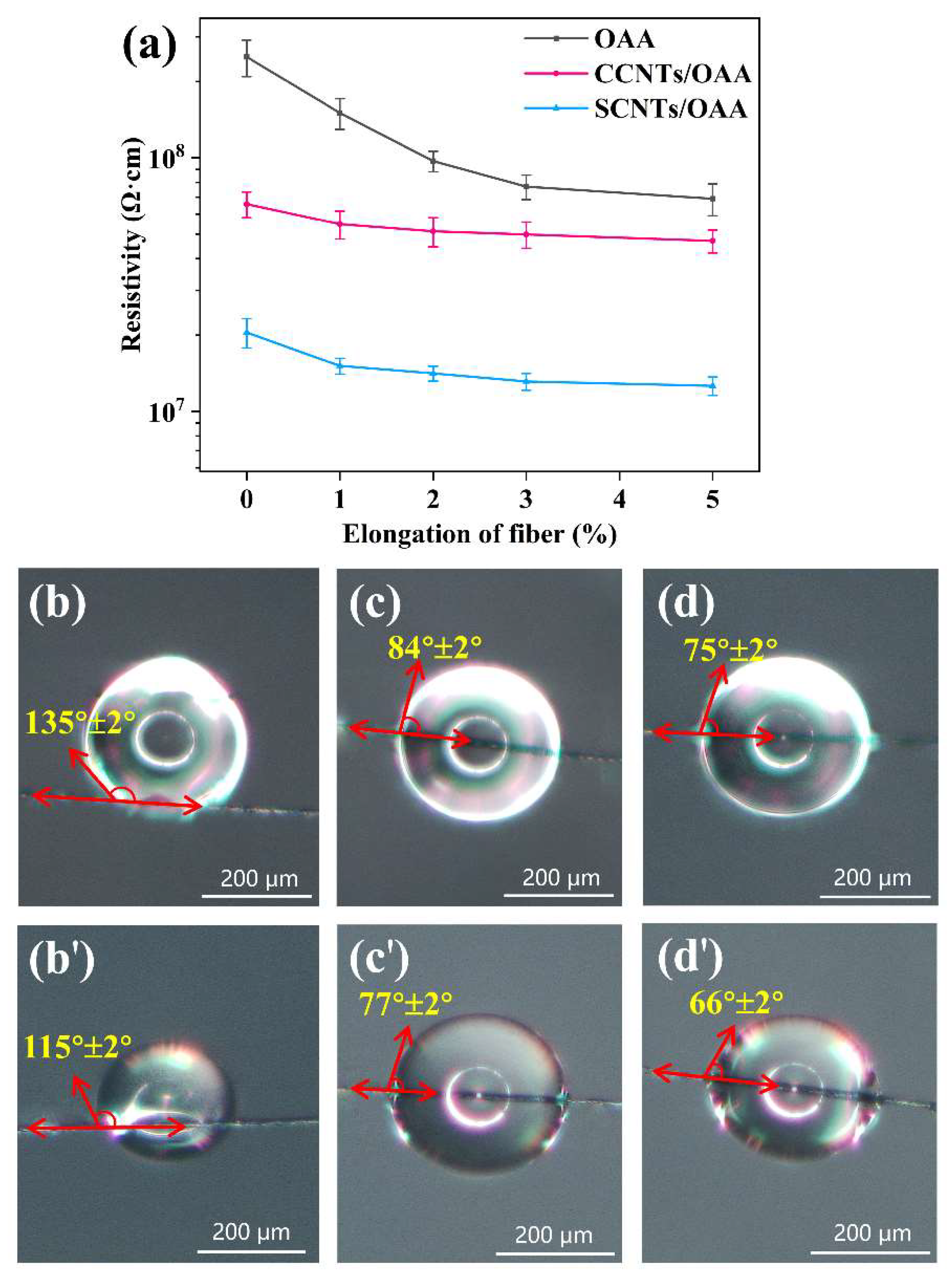Enhancing Anti-Static Performance of Fibers by Construction of the Hybrid Conductive Network Structure on the Fiber Surface
Abstract
:1. Introduction
2. Experimental
2.1. Materials
2.2. Synthesis of SCNTs
2.3. Preparation and Application of Hybrid Antistatic Agent
2.4. Characterizations and Testing
3. Results and Discussion
3.1. Characterizations of SCNTs
3.2. Mechanism Analysis of Antistatic on Fiber Surface
3.3. Effects of Fiber Stretching on Conductive Layer and Mechanism Analysis
4. Conclusions
Author Contributions
Funding
Institutional Review Board Statement
Informed Consent Statement
Data Availability Statement
Conflicts of Interest
References
- He, H.; Yan, Y.; Qiu, Z.; Tan, X. A novel antistatic polyurethane hybrid based on nanoscale ionic material. Prog. Org. Coat. 2017, 113, 110–116. [Google Scholar] [CrossRef]
- Chen, S.; Zhou, B.; Ma, M.; Shi, Y.; Wang, X. Permanently antistatic and high transparent PMMA terpolymer: Compatilizer, antistatic agent, and the antistatic mechanism. Polym. Adv. Technol. 2018, 29, 1788–1794. [Google Scholar] [CrossRef]
- Hausmann, K. Permanent antistatic agent offers long term performance for films and containers. Plast. Addit. Compd. 2007, 9, 40–42. [Google Scholar] [CrossRef]
- Gürakın, H.K.; Turan, A.C.; Deligöz, H. Synthesis of a novel polyester-ether copolymer and its derivatives as antistatic additives for thermoplastic films. Polym. Test. 2019, 81, 106214. [Google Scholar] [CrossRef]
- Gao, W.; Dang, Z.-C.; Liu, F.-S.; Wang, S.; Zhang, D.-W.; Yan, M.-X. Preparation of antistatic epoxy resin coatings based on double comb-like quaternary ammonium salt polymers. RSC Adv. 2020, 10, 43523–43532. [Google Scholar] [CrossRef]
- Kugimoto, Y.; Wakabayashi, A.; Dobashi, T.; Ohnishi, O.; Doi, T.K.; Kurokawa, S. Preparation and characterization of composite coatings containing a quaternary ammonium salt as an anti-static agent. Prog. Org. Coat. 2016, 92, 80–84. [Google Scholar] [CrossRef]
- Zhang, Q.; Wang, J.; Zhang, B.-Y.; Guo, B.-H.; Yu, J.; Guo, Z.-X. Improved electrical conductivity of polymer/carbon black composites by simultaneous dispersion and interaction-induced network assembly. Compos. Sci. Technol. 2019, 179, 106–114. [Google Scholar] [CrossRef]
- Choi, H.-J.; Kim, M.S.; Ahn, D.; Yeo, S.Y.; Lee, S. Electrical percolation threshold of carbon black in a polymer matrix and its application to antistatic fibre. Sci. Rep. 2019, 9, 6338. [Google Scholar] [CrossRef] [PubMed] [Green Version]
- Silva, T.F.d.; Menezes, F.; Montagna, L.S.; Lemes, A.P.; Passador, F.R. Preparation and characterization of antistatic packaging for electronic components based on poly(lactic acid)/carbon black composites. J. Appl. Polym. Sci. 2019, 136, 47273. [Google Scholar] [CrossRef]
- Santos, M.S.d.; Montagna, L.S.; Rezende, M.C.; Passador, F.R. A new use for glassy carbon: Development of LDPE/glassy carbon composites for antistatic packaging applications. J. Appl. Polym. Sci. 2019, 136, 47204. [Google Scholar] [CrossRef]
- de Souza Vieira, L.; Montagna, L.S.; Marini, J.; Passador, F.R. Influence of particle size and glassy carbon content on the thermal, mechanical, and electrical properties of PHBV/glassy carbon composites. J. Appl. Polym. Sci. 2021, 138, 49740. [Google Scholar] [CrossRef]
- Zhu, Y.; Zhao, Y.; Zhang, X.; Wang, L.; Wang, X.; Zhang, J.; Han, P.; Qiao, J. Metal filaments/nano-filler filled hybrid polymer fibers with improved conductive performance. Mater. Lett. 2016, 173, 26–30. [Google Scholar] [CrossRef]
- Shang, Q.; Hao, S.; Wang, W.; Fu, D.; Ma, T. Preparation and characterization of antistatic coatings with modified BaTiO3 powders as conductive fillers. J. Adhes. Sci. Technol. 2013, 27, 2642–2652. [Google Scholar] [CrossRef]
- Lv, P.; Zhao, Y.; Liu, F.; Li, G.; Dai, X.; Ji, X.; Dong, Z.; Qiu, X. Fabrication of polyaniline/polyimide composite fibers with electrically conductive properties. Appl. Surf. Sci. 2016, 367, 335–341. [Google Scholar] [CrossRef]
- Szeluga, U.; Kumanek, B.; Trzebicka, B. Synergy in hybrid polymer/nanocarbon composites. A review. Compos. Part A Appl. Sci. Manuf. 2015, 73, 204–231. [Google Scholar] [CrossRef]
- Wang, H.; Xie, G.; Fang, M.; Ying, Z.; Tong, Y.; Zeng, Y. Electrical and mechanical properties of antistatic PVC films containing multi-layer graphene. Compos. Part B Eng. 2015, 79, 444–450. [Google Scholar] [CrossRef]
- Qin, W.; Vautard, F.; Drzal, L.T.; Yu, J. Mechanical and electrical properties of carbon fiber composites with incorporation of graphene nanoplatelets at the fiber–matrix interphase. Compos. Part B Eng. 2015, 69, 335–341. [Google Scholar] [CrossRef]
- Fang, M.; Xiong, X.; Hao, Y.; Zhang, T.; Wang, H.; Cheng, H.-M.; Zeng, Y. Preparation of highly conductive graphene-coated glass fibers by sol-gel and dip-coating method. J. Mater. Sci. Technol. 2019, 35, 1989–1995. [Google Scholar] [CrossRef]
- Seki, Y.; Ince, M.; Yıldız, N.; Seki, Y.; Ergül, O.; Sever, K.; Sarıkanat, M. The effect of methyl-tri-n-butylammonium methylsulfate and graphite nanoplates on production of antistatic acrylic polymer. Polym.-Plast. Technol. Mater. 2019, 58, 1471–1479. [Google Scholar] [CrossRef]
- Atiq Ur Rehman, M.; Chen, Q.; Braem, A.; Shaffer, M.S.P.; Boccaccini, A.R. Electrophoretic deposition of carbon nanotubes: Recent progress and remaining challenges. Int. Mater. Rev. 2020, 1–30. [Google Scholar] [CrossRef]
- Zhang, X.; Lu, W.; Zhou, G.; Li, Q. Understanding the Mechanical and Conductive Properties of Carbon Nanotube Fibers for Smart Electronics. Adv. Mater. 2020, 32, 1902028. [Google Scholar] [CrossRef]
- Duongthipthewa, A.; Su, Y.; Zhou, L. Electrical conductivity and mechanical property improvement by low-temperature carbon nanotube growth on carbon fiber fabric with nanofiller incorporation. Compos. Part B Eng. 2020, 182, 107581. [Google Scholar] [CrossRef]
- Liu, Z.; Li, L.; Zhao, Z.; Liu, Y.; Lu, M. Antistatic silk fabric through sericin swelling-fixing treatment with aminated carbon nanotubes. Mater. Sci. Eng. B 2017, 226, 72–77. [Google Scholar] [CrossRef]
- Wang, C.X.; Lv, J.C.; Ren, Y.; Zhi, T.; Chen, J.Y.; Zhou, Q.Q.; Lu, Z.Q.; Gao, D.W.; Jin, L.M. Surface modification of polyester fabric with plasma pretreatment and carbon nanotube coating for antistatic property improvement. Appl. Surf. Sci. 2015, 359, 196–203. [Google Scholar] [CrossRef]
- Zhang, M.; Zhang, C.; Du, Z.; Li, H.; Zou, W. Preparation of antistatic polystyrene superfine powder with polystyrene modified carbon nanotubes as antistatic agent. Compos. Sci. Technol. 2017, 138, 1–7. [Google Scholar] [CrossRef]
- Ferreira Braga, N.; Morales Zaggo, H.; Stieven Montagna, L.; Roberto Passador, F. Effect of Carbon Nanotubes (CNT) Functionalization and Maleic Anhydride-Grafted Poly(trimethylene terephthalate) (PTT-g-MA) on the Preparation of Antistatic Packages of PTT/CNT Nanocomposites. J. Compos. Sci. 2020, 4, 44. [Google Scholar] [CrossRef]
- Tian, Y.; Zhong, J.; Hu, L.; Zheng, X.; Cheng, J.; Pu, Z. Preparation of carbon nanotubes/polyethersulfone antistatic composite materials by a mixing process. Polym. Compos. 2020, 41, 556–563. [Google Scholar] [CrossRef]
- Yu, M.M.; Xu, C.C.; Ren, M.S.; Sun, J.L. Faming Zhuanli Shenqing Gongkai Shuomingshu. China Patent CN202110343345.7, 22 June 2021. [Google Scholar]
- Yang, D.; Hu, J.; Wang, C. Synthesis and characterization of pH-responsive single-walled carbon nanotubes with a large number of carboxy groups. Carbon 2006, 44, 3161–3167. [Google Scholar] [CrossRef]
- Dilsiz, N.; Wightman, J.P. Surface analysis of unsized and sized carbon fibers. Carbon 1999, 37, 1105–1114. [Google Scholar] [CrossRef]
- Fowkes, F.M. Additivity of intermolecular forces at interfaces. I. determination of the contribution to surface and interfacial tensions of dispersion forces in various liquids1. J. Phys. Chem. 1963, 67, 2538–2541. [Google Scholar] [CrossRef]
- Owens, D.K.; Wendt, R.C. Estimation of the surface free energy of polymers. J. Appl. Polym. Sci. 1969, 13, 1741–1747. [Google Scholar] [CrossRef]








| Ingredient | Serial Number | Masses |
|---|---|---|
| 2-pentanol, 1,1′,1″,1‴-(1,2-ethandiyldinitrilo) tetrakis | A | 25 g |
| polyoxyethylene fatty acid | B | 20 g |
| primary alcobol ethoxylate | C | 30 g |
| hexadecyl trimethyl ammonium bromide | D | 20 g |
| alkapolpeg-400 | E | 80 g |
| Sample | OAA-Treated Fiber | CCNTs/OAA-Treated Fiber | SCNTs/OAA-Treated Fiber |
|---|---|---|---|
| (mJ·m−2) | 8.58 | 22.85 | 29.35 |
| (mJ·m−2) | 8.42 | 19.23 | 23.86 |
| (mJ·m−2) | 0.16 | 3.62 | 5.49 |
Publisher’s Note: MDPI stays neutral with regard to jurisdictional claims in published maps and institutional affiliations. |
© 2021 by the authors. Licensee MDPI, Basel, Switzerland. This article is an open access article distributed under the terms and conditions of the Creative Commons Attribution (CC BY) license (https://creativecommons.org/licenses/by/4.0/).
Share and Cite
Xu, C.; Fang, L.; Yu, M.; Ren, M.; Sun, J.; Zhang, L. Enhancing Anti-Static Performance of Fibers by Construction of the Hybrid Conductive Network Structure on the Fiber Surface. Polymers 2021, 13, 2248. https://doi.org/10.3390/polym13142248
Xu C, Fang L, Yu M, Ren M, Sun J, Zhang L. Enhancing Anti-Static Performance of Fibers by Construction of the Hybrid Conductive Network Structure on the Fiber Surface. Polymers. 2021; 13(14):2248. https://doi.org/10.3390/polym13142248
Chicago/Turabian StyleXu, Congcong, Lin Fang, Mingming Yu, Musu Ren, Jinliang Sun, and Liying Zhang. 2021. "Enhancing Anti-Static Performance of Fibers by Construction of the Hybrid Conductive Network Structure on the Fiber Surface" Polymers 13, no. 14: 2248. https://doi.org/10.3390/polym13142248
APA StyleXu, C., Fang, L., Yu, M., Ren, M., Sun, J., & Zhang, L. (2021). Enhancing Anti-Static Performance of Fibers by Construction of the Hybrid Conductive Network Structure on the Fiber Surface. Polymers, 13(14), 2248. https://doi.org/10.3390/polym13142248








